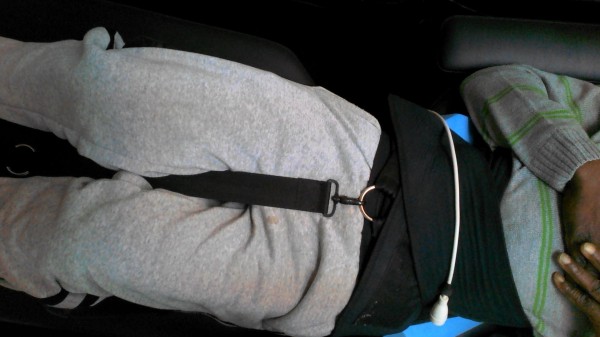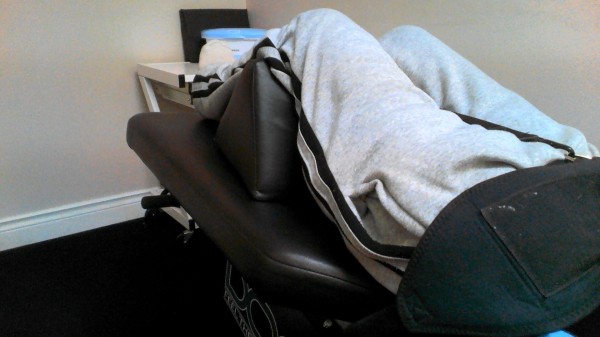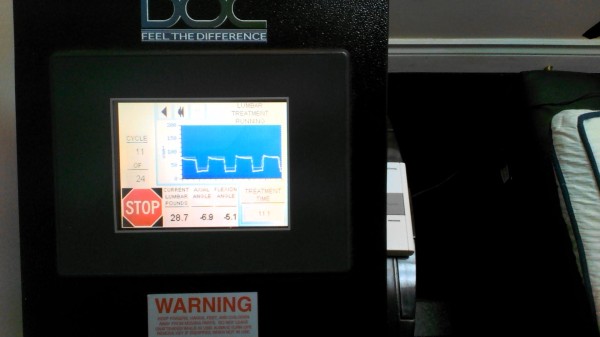Examination Date: 2014-03-17
Initial Exam
Chief Complaints
1. Bilateral Lower Back
Following is a case of acute lower back and our treatment. Patient has a complaint of bilateral lower back pain. He rated this pain as a 7 on a scale of 0 to 10 with 10 being the worst.
History
Mr. XXXXX has recorded that his family doctor is Dr. Hirsch. The patient denies any surgeries within the past five years.
Physical Examination
Physical examination revealed an individual who was alert, cooperative and orientated.
The patient had a limping gait. The limp appeared on the left. The patient had an antalgic lean to the right. Minor’s sign was positive.
Sex: Male
Age: 61
Height: 173 cm
Weight: 74 kg
BMI: 24.7
BP: 144/65
Pulse: 63/bpm
Complexion: Normal
Size: Normal
Grip strength: Normal bilaterally.
Posture
There is no indication of a head tilt in the patient’s posture. Mr. XXXXX shoulder level appeared high on the right. There is no evidence of a forward head carriage. There was a high right ilium. Observation and inspection of the thoracic spine revealed a normal spine. Profile view of the lumbar spine revealed normal curvature. Left heel walk: UTP. Right heel walk: WNL. Left toe walk: WNL. Right toe walk: WNL.
Ranges of Motion
Lumbar Spine
Motion Degree Normal Pain Level
Flexion: 20 60 Significant
Extension: 20 25 Moderate
Lateral Right: 25 25 Moderate
Lateral Left: 10 25 Moderate
Neurological Testing
Reflexes Wexler’s Grading System
L R
Patellar (L2, 3, 4) 2+ 2+
Achilles (S1, 2) 1+ 2+
Jendrassik was not required.
Lower Extremities:
Left Right
L-4 Equal
L-5 Equal
S-1 Decrease
Lumbar Spine Evaluation
Lumbar spine evaluation provided the following results:
Evaluation of the lumbar spinal region reveals tender areas in the lumbar region on both sides (grade 2) and erector spinae on both sides (grade 2). Evaluation of the lumbar spinal areas indicates that trigger points are present in the erector spinae bilaterally (moderate) and quadratus lumborum bilaterally (moderate). Kemps was positive on the left. Kemps was negative on the right. The following lumbar orthopedic tests were negative: SLR passive on both sides (80 deg). The following lumbar orthopedic tests were positive: SLR active left (60 deg).
Lower Extremities Muscle Testing
Tibialis 5/5 5/5
Extensor Hallucis Longus 5/5 5/5
Peroneous Longus 4/5 5/5
Mr. XXXXX demonstrated S1 (ankle PF) of 47 lbs on the right and 32 lbs on the left.
Diagnosis
M5416 Radiculopathy, lumbar region
Acute, moderate to severe traumatic joint and muscle dysfunction in the above region with associated symptoms of pain, ROM reduction and functional difficulties.
Management Plan
Short Term Goals would be for Mr. XXXXX to report 50% pain reduction and 50% increase in ROM within 2 weeks. Functionally Mr. XXXXX should also be able to perform half of his ADL’s within these 2 weeks easier. Long Term Goals would be for Mr. XXXXX to report over 80% pain reduction and demonstrate over 80% increase in ROM within 4 to 6 weeks. Functionally Mr. XXXXX should also be able to perform most of his ADL’s within this period. Mr. XXXXX is also to be discharged with a home exercise program when the above goals have been achieved and he is over 80-90% impairment free.
Spinal Decompression 5x per week/duration of 2 weeks
Lumbar stability exercises 3x per week/duration of 2 weeks (to stabilize lumbar spine in a pain free manner)
Home Exercise Program 1x (for the patient to follow a sound home exercise program to increase flexibility, strength and endurance)
Today’s Treatments
Today’s treatment consisted of Spinal Decompression (Supine,6,60 lbs, L5-S1 deg and 20min NP) in the lumbar region.
Notes:
This patient is in tremendous amount of pain. He has antalgic posture, can not stand straight. He has neurological signs of reduction of DTR on the left S1; although he can perform heel and toe walk when digital force gage is used he shows 15lbs more DF on the right vs left. He does not have any MR imaging yet, but I would suspect that if he did a disc injury will show.
DOC Settings:
Supine: Although I preferred prone, he said that he prefers supine, so for this first treatment I chose supine.
Protocol 6: This is good starting point with may pulls and rests.
Force: 60 lbs. This patient is 74 Kg or 163 lbs, to get some results I chose 60 lbs, we could have chosen 50 lbs, but with a patient this size I would almost never will go below 50 lbs.
Angle: originally I had him at 0 (flat), but when I added some flexion he felt better so I gave him some flexion at L5-S1 level. I also rotated table counter-clock wise (looking from the bottom of the table where the nobs are) and side bent away from pain before starting the decompression.
Time/Cycle: I usually choose 15 min of treatment but in this patient I decided to chose 20 min because I felt he could take it.
This patient was referred to us by his medical doctor. Patient felt great after treatment. Although radiculopathy was still present he said he could walk easier.
SOAP Notes – Detail (7th Visit)
2014-03-25
Subjective Complaint
Mr. XXXX was evaluated today for progress and response to treatment. Mr. XXXX stated that his symptoms have gotten better since the last visit. Patient states that he is transferring, sleeping, sitting, standing and walking, easier than before.
Objective
Tenderness was found in the lumbar region. Trigger points where noted in the lumbar area. Patient is able to transfer, sit, stand and walk, easier than before. Lumbar range of motion has increased.
Assessment
The patients symptoms appear to be improved since the last visit.
Plan
After today’s visit, Vincent should continue with therapy as directed. Mr. XXXX should continue with the current treatment plan.
Today’s Treatment
Mr. XXXX was treated today with: interferential (Swing (1-150 Hz 10-20 min)) in the lumbar region; Spinal Decompression (Pron,2,80 lbs,-6deg and20min NP) in the lumbar region. Diagnosis consisted of: M5416 – Radiculopathy and lumbar region. Acute, moderate to severe traumatic joint and muscle dysfunction in the above region with associated symptoms of pain, ROM reduction and functional difficulties.
Notes:
Above is a great example of a success story with spinal decompression. This patient can now stand straight, walk, sit and transfer easier. His ROM has improved and now he is going away on a vacation. I changed his position to prone and added more weight and Electrotherapy to reduce muscle spasm while being decompressed. To keep it objective no other treatments were rendered. Exercises will be given for lumbar stability.



